Alaskan Prospecting Adventures
There are a number of operators beginning to offer this type of unique recreation, including the Moore Creek Mine in the Iditarod area, the Gaines Creek Mine and several others. This new tourism offers significant benefits to both the mine owners and the visitors. Visitors have the opportunity to potentially find some very significant gold while experiencing the beauty of the Alaskan wilderness. Visitors at both Moore and Gaines have produced some very large nuggets and even for those who do not set records, many visitors find the largest nuggets they have ever found. On the other hand, mine owners gain a new and unique source of financing mine exploration and other operations. Initial funding to get a project off the ground can be difficult to acquire and tourism offers a very unique and creative way to gain those first seed monies for a property.


During the summer of 2006, I had to opportunity to visit and sample the primitive Alaskan mining experience for myself – I went to visit the Moore Creek gold mine. I’ve been prospecting for 30 years, but it was an experience like nothing I have ever done before. There is no practical access to the mine, except by air. I went in with 9 other guys – we met in Anchorage, and flew together to the little Alaskan community of McGrath. From there, our bush pilot, Mike Stewart, was able to transport us and our gear from McGrath out to the mine in three trips. The flight into the mine with the Mike was really exciting with spectacular views of the surrounding country. I have never flown in a little single engine plane before, so this was a real first for me. The runway in McGrath was paved, but out at the mine it was just dirt and grass. In such a little plane you really get the feel for how fragile the plane is and how the dangerous outcome can be if you have any problems. Mike is a very safe pilot and there were no problems at all.
It was so strange to me that it was never dark the entire time I was there. I think the sun set around 12:30 at night, and rose again around 4:15 am, but it was like dusk the entire time in between, so it was never really dark enough to see any stars. Evening campfires were held in what seemed to be essentially full daylight. This gave those participants who desired to do so hours of extra time in the evening to prospect. One night I went to bed at 11 pm and the sun was shining through a window in my tent right into my eyes – that’s something I’d never experience at home.It was cloudy most of the time and rained at least a little bit everyday, thought most days the rain was just a short shower or two for maybe 10 minutes at a time. It reminded me of a similar situation in Seattle where I was told that kind of drizzle was considered a “dry rain”.
There was lots of wildlife, and beavers, rabbit, birds, wolves, etc. were in or around our camp. We saw moose droppings, but no moose. The only bears we saw were viewed from the air in a plane. However, we did find fresh bear prints in the mud about 150 feet from our tents one morning after it had rained.
Most of the guys in my group brought their own metal detectors, including me. While it may be easy to bring in a metal detector as they are comparatively light, Moore Creek offers a quite a selection of gold recovery equipment to the visitor. A number of different types of metal detectors are also available for visitors to use at the mine. In addition, the mine has several Keene Dredges including a 6 incher, several high bankers, a gold wheel, sluice boxes and pans – for the most part all the items a prospector would need to find and recover gold on the property. Owner Steve Herschbach’s idea is that, other than those that want to bring their own detector, the mine can provide whatever prospecting equipment is needed for the week – that the visitor really only need bring a sleeping bag, clothes and personal effects, as the mine will provide the necessary equipment. This works out well as Steve is part owner of Alaska Mining and diving supply in Anchorage and is a dealer of the equipment he provides.

Beavers swim in the Moore Creek ponds.
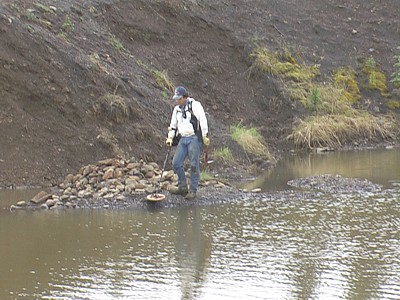
The facilities at the Moore Creek Mine are very comfortable with large cots and two men assigned to each roomy tent. The tents are pitched on a flat along side a stream at the site of and old camp marked by original log cabins that are still in use. Tasty and hearty meals were provided each day by camp cook Bob Herschbach, Steve’s cousin.
Moore Creek is in the rolling hill country at the base of one of the local mountain ranges. The area topography is old and well-rounded with few steep slopes or rugged rock outcrops. Erosion is generally small and the surface exposures have changed only a little since Pleistocene times. Drainage gradients are fairly flat and Moore Creek meanders back and forth across the valley that contains it. The creek heads in the divide that separates streams flowing into the Kuskokwim River from those that flow into the Yukon River. Moore Creek and others to the east flow into the Kuskokwim River. Bonanza Creek, just over the low divide from the headwaters of Moore Creek, and other creeks to the west, flow into the Yukon River.
The elevation at Moore Creek Mine is about 900 feet above sea level. Willow Mountain peak is just two miles away, and at 3009 feet and is the highest point in the area. The hill immediately above the mining camp on which the Broken Shovel vein outcrops crests at 2225 feet. The timberline in the area is at roughly 1,500 feet. Moore Creek is surrounded mainly by spruce forests in the flat areas around Moore Creek itself and the surrounding hills, with scattered birch and cottonwood. Thick alder and willow grow from the timberline to about 2,000 feet, and higher elevations are covered with tundra, moss, and lichen growth. All disturbed ground, such as old mine workings, trails, and ditches are commonly grown over with thick alders and willows. Some drier tailing piles have light spruce and birch stands, especially on the north sides of the piles.
Placer gold was first identified in the Iditarod area at Otter Creek on Christmas Day, 1908, by gold prospectors W.A. Dikeman and John Beaton. This was the first discovery in the region and word spread fast. By the summer of 1909, many prospectors, including several hundred from the Alaskan boomtowns of Fairbanks and Nome, had arrived into that remote country. Prospectors spread out from the discovery site on Otter Creek and began to make a number of additional placer discoveries in the area. The town sites of Flat and Discovery were established on Otter Creek.
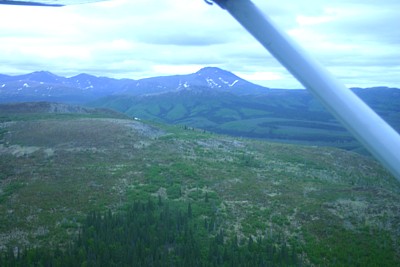
The spectacular views flying in to the mine.
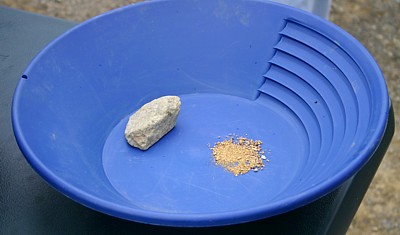
The Gold I Found Highbanking at Moore Creek.
Bedrock underlying upper Moore Creek is Upper Cretaceous sedimentary rocks consisting of interbedded sandstone and shale. The placer deposit occurs in multiple ages of ancestral terrace gravels and in modern stream gravels. The bed of Moore Creek has moved by erosion in a southeasterly direction, leaving behind considerable terrace or bench gravels. The older terrace deposits are inferred to be Late Tertiary to early Pleistocene in age, based on similarities with other dated deposits in Interior Alaska.
In the modern stream, gravel averages about 10 ft thick. On the bench placers the gravel is shallower, only about 3 ft thick and covered by roughly 2 ft of clay and vegetation. The placer paystreak is about 1.9 mi (3 km) long and 330 to 1310 ft (100 to 400 m) wide. Pay gravels range from 13 to 20 ft (4 to 6 m) thick and are overlain by 5 to 6.6 ft (a.5 to 2 m) of overburden. Gold is concentrated at the base of the gravel and the upper 1.5 ft (0.46 m) of bedrock. The gold is associated with considerable vein quartz. Reported gold fineness ranges from 746 to 883 with averages in the high 700's, this is quite high in silver and low in gold compared to other deposits in the Innoko and Iditarod districts. The largest nugget found while Steve has owned the property was a 24.7 ouncer found by a tourist visitor to the property in 2005. A $2000.00 nugget is reported to have been found on Nevada Gulch in the early years, which, if true, would have been a nugget exceeding 100 ounces in weight, given the purity of the Moore Creek gold and early gold prices.

Raking through the gravels detecting for gold
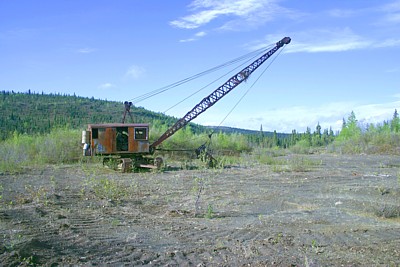
Other than what is attached to the nuggets themselves, there is very little vein quartz present in the gravels. This perhaps the most unique feature of the location as vein quartz is very common in placer gravels throughout the world. Some chalcedony and agate derived from the volcanic rocks to the north are present, but vein quartz is very rare. The principal heavy minerals identified in concentrates from placer operations include native gold, cinnabar, scheelite, native silver, tetrahedrite, chromite, magnetite, and zircon.
The source of the gold is likely a mineralized monzonite intrusion and associated contact zones about 1.2 mi northwest and upstream from the placer deposit. Gulches converging on the intrusion have all been mined for gold. The northeast trending Iditarod-Nixon Fork fault forms the southern structural boundary of the intrusion. It is postulated that the Late Tertiary to possibly Late Pleistocene placer deposits at Moore Creek may have been successively offset right laterally by transcurrent movement along the fault. This would make the deposits progressively younger to the northeast. Many of the large gold/quartz specimens that have been recovered have some monzonite attached, possibly indicating a source within the cupola of the intrusive. However, others have attached volcanic material indicating at least some of the cupola fracture zone which gave rise to the veins continues beyond the rim of the pluton into the volcanics.It has been estimated that there is a minimum of 11,000 cy of virgin gravel with potentially significant gold content. An unknown amount of gold remains in the 1.5 million yards of tailings that line Moore Creek for nearly 2 miles. Much of the tailings are worthless stacked overburden, but certain others appear to contain significant amounts of gold and offer real potential for re-working, as the early recovery systems were not very efficient. With the recent increases in the price of gold, Steve and his partners in the Moore Creek venture are seriously considering the possibility of reworking some of the old tailing piles and possibly some of the areas of virgin ground left behind by the former operators. His first goal in that process is to get the mine’s runway extended so he can bring in planes with greater carrying capacity. This will allow him to bring in modern earth moving and gold recovery equipment as the existing equipment on site is very old and inefficient.
Moore Creek Mine Owner Steve Herschbach and his partners have recently leased out the property to a Vancouver mining company, Full Metals Minerals (FMM-TSX:V) to explore for hard rock deposits on the property. Arrangements are such that this does not impede the ongoing tourist operation. Moore Creek mine is not too many miles from the recent big gold strike at Donlin where Barrick and Novagold have discovered a 28 million ounce gold resource. The Moore Creek property has been only lightly explored for in place lode-gold deposits and may hold significant potential.
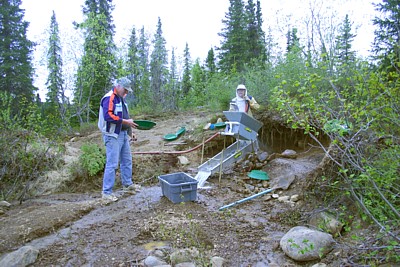
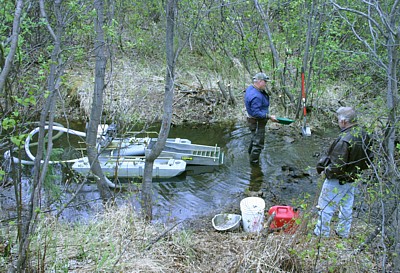
While I was up at the mine, a team of geologists from Full Metals was exploring the property, taking samples and mapping the area geology. While it is generally believed that the most likely locations for any gold bearing resources still in place lie within the Monzonite pluton on the hill above the mine and the volcanic rocks adjacent to it, other possibilities were being considered. Future plans for drilling and other efforts will be determined based on the results of the current exploration efforts.
Success in detecting nuggets within the old tailings piles requires good technique, hard work and some luck. You have to cover as much ground as possible and do it properly. This gives you the most chances of finding some of those big nuggets – but you also need a bit of luck as well. I had the bad fortune of getting a blister on my heel the first whole day we were there and it slowed me down the rest of the week. For hose who visit, don't hike too far in new shoes, and take care of your feet.
The group I went in with was a really great bunch of guys, but as for me, my luck was as bad as its ever been. I never got my detector over a single piece of gold – I was completely skunked for the entire week. I dug at least 50 targets – all trash. As an example of my luck, one of the last days I went out and crossed a small stream and turned right and hunted some tailing piles, I found only junk targets with my detector. The next day, another guy from the group crossed at the same point, turned left went about 10 feet and found a 2 ounce nugget – that’s just the way the ball bounces. The nuggets are just kind of spread all over in the old mine tailing piles and there is no way to know in advance where they are – so a bit of luck does play a part. On the other hand, Glen, one of the other guys in our group, really had the lucky hand – he got more than a pound of gold during the week, including 5 pieces over an ounce. He worked very hard and his largest nugget was over three ounces in weight. He told me he was digging around 4 trash targets to every one gold target and that was far better results than I achieved. By the end of the week, folks were calling him “Mr. Lucky” - His luck for the week was pretty much the exact opposite of mine. I was getting a little discouraged with the detecting, so I started spending part of my time shoveling gravel into a high banker. Moore Creek offers a lot more possibilities than just detecting. I did a bit better there and I recovered seven pennyweight of fines doing that – so I at least had some nice Alaskan gold to bring home. The detecting is a hit or miss type of thing, but the high banking and dredging operations offer a surer chance to get some gold. The odds for a spectacular big nugget find may be less, but the gold more sure.
All of that considered, the bottom line is that you don’t have to find a ton of gold to really enjoy and appreciate the remote gold country of Alaska. It was the trip of a lifetime for me – a beautiful and very isolated, unspoiled country different from any I’d ever experienced. Great guys to prospect with, good folks in charge of the operation, good food and a comfortable camp all added up to a trip I’ll never forget. Additional information about Moore Creek can be found over the internet.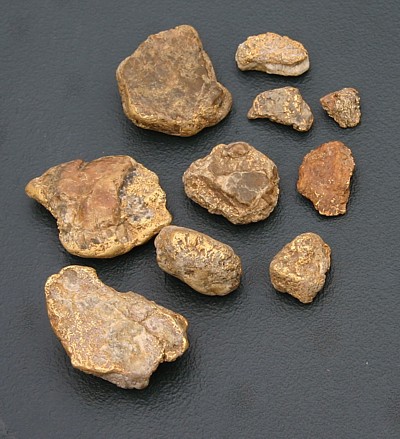
Over a pound of large nuggets detected at Moore Creek
The Above Article is Copyrighted by Chris Ralph, and May Not be Copied or Quoted Without Permission

